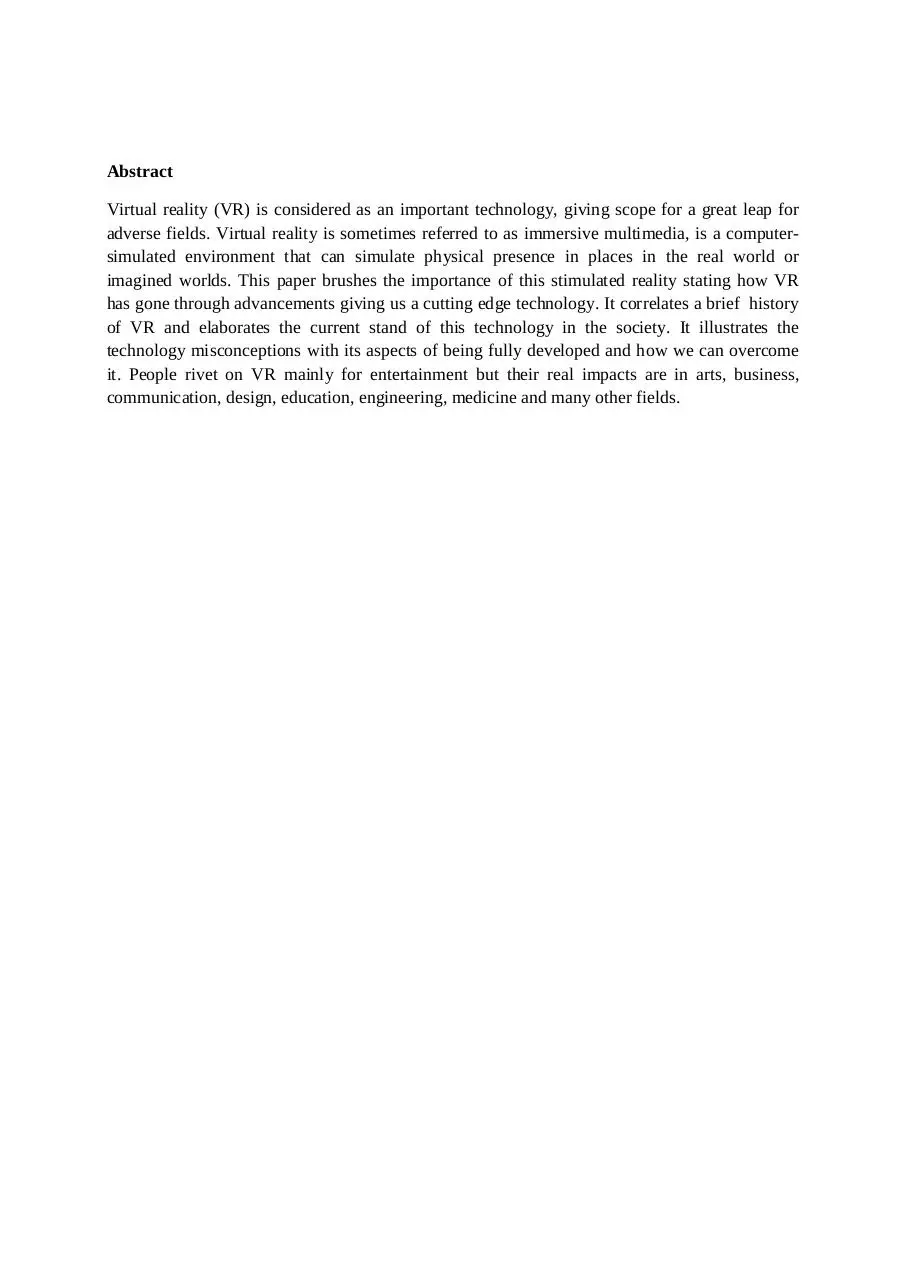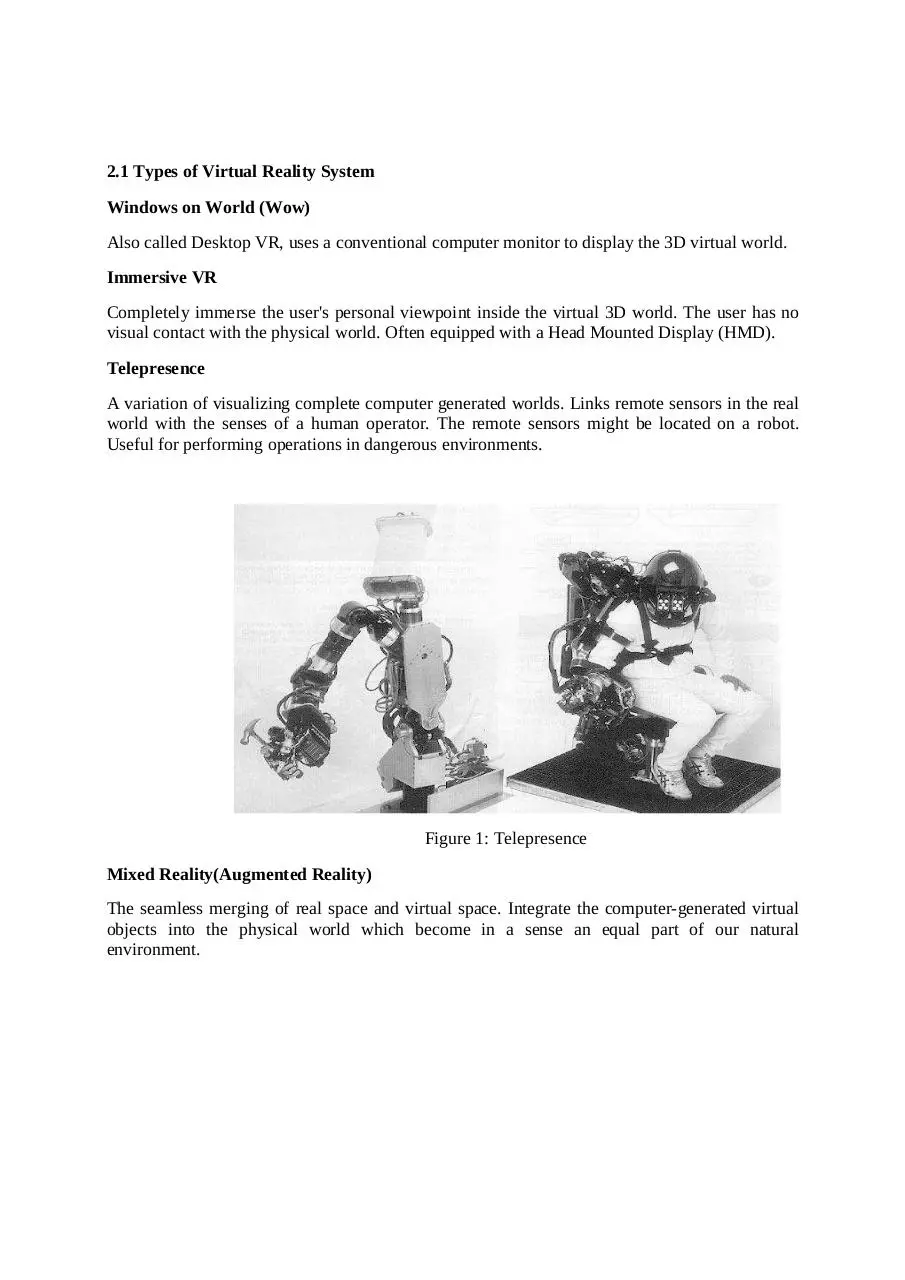g6 (PDF)
File information
Title: g6
Author: KHALEEL
This PDF 1.5 document has been generated by PDFCreator 2.0.0.0, and has been sent on pdf-archive.com on 21/04/2015 at 09:27, from IP address 196.220.x.x.
The current document download page has been viewed 691 times.
File size: 524.39 KB (13 pages).
Privacy: public file





File preview
TERM PAPER ON
APPLICATION OF VIRTUAL REALITY TO THE CURRENT WORLD
BY
GROUP 6
COMPUTER GRAPHICS AND VISUALIZATION
(COSC 415)
DEPARTMENT OF MATHEMATICS
AHMADU BELLO UNIVERSITY, ZARIA
GROUP 6 MEMBERS
NAMES
REG NO
SIGN
ADAMU UMAR
U12CS2018
______
SADIQ KHALIL ABUBAKAR
U12CS2019
______
HARUNA ABDULLAHI KAWO
U12CS2022
______
YAHAYA AUWAL
U12CS2023
______
SULEIMAN HABIBA YUSUF
U12CS2026
______
HARUNA YUSUF MURTALA
U12CS2028
______
DAHIRU MARYAM
U12CS2029
______
JIBRIN MUSA KHALIL
U12CS2032
______
MADANDOLA MANSORAT RANTI’OLA
U12CS3002
______
ADAMS MUSTAPHA
U13CS3001
______
ABDULLAHI ABDULLAHI
U13CS3002
______
ABDULKADIR MUSTAPHA SANI
U13CS3004
______
Abstract
Virtual reality (VR) is considered as an important technology, giving scope for a great leap for
adverse fields. Virtual reality is sometimes referred to as immersive multimedia, is a computersimulated environment that can simulate physical presence in places in the real world or
imagined worlds. This paper brushes the importance of this stimulated reality stating how VR
has gone through advancements giving us a cutting edge technology. It correlates a brief history
of VR and elaborates the current stand of this technology in the society. It illustrates the
technology misconceptions with its aspects of being fully developed and how we can overcome
it. People rivet on VR mainly for entertainment but their real impacts are in arts, business,
communication, design, education, engineering, medicine and many other fields.
1.
Introduction
Virtual Reality refers to a high-end user interface that involves real-time simulation and
interactions through multiple sensorial channels. VR is able to immerse you in a computergenerated world of your own making: a room, a city, the interior of human body etc. With VR,
you can explore any uncharted territory of the human imagination.
Brief history of virtual reality, In 1950s, flight simulators were built by US Air Force to train
student pilots, in 1965, a research program for computer graphics called “The Ultimate Display”
was laid out, in 1988, commercial development of VR began and in 1991, first commercial
entertainment VR system "Virtuality" was released.
The rest of the paper is organized as follows; section 2.1 types of virtual reality system, 3.1
technologies of virtual reality, 4.1 architecture of virtual reality, 5.1 application of virtual reality,
6.1 advantages of virtual reality, 7.1 future work, 8.1 concludes the paper.
2.1 Types of Virtual Reality System
Windows on World (Wow)
Also called Desktop VR, uses a conventional computer monitor to display the 3D virtual world.
Immersive VR
Completely immerse the user's personal viewpoint inside the virtual 3D world. The user has no
visual contact with the physical world. Often equipped with a Head Mounted Display (HMD).
Telepresence
A variation of visualizing complete computer generated worlds. Links remote sensors in the real
world with the senses of a human operator. The remote sensors might be located on a robot.
Useful for performing operations in dangerous environments.
Figure 1: Telepresence
Mixed Reality(Augmented Reality)
The seamless merging of real space and virtual space. Integrate the computer-generated virtual
objects into the physical world which become in a sense an equal part of our natural
environment.
Figure 2: Augmented Reality
Distributed VR
A simulated world runs on several computers which are connected over network and the people
are able to interact in real time, sharing the same virtual world.
Figure 3: Distributed VR
3.1 Technologies of Virtual Reality
Hardware Technologies
Head-Mounted
Mounted Display (HMD)
A Helmet or a face mask providing the visual and auditory displays, use
se LCD or CRT to display
stereo images and may
ay include built-in
built head-tracker
tracker and stereo headphones
Figure 4: Head Mounted Display (HMD)
Binocular Omni-Orientation
Orientation Monitor (BOOM)
Head-coupled
coupled stereoscopic display device,
device uses CRT to provide high-resolution
resolution display,
display it is
convenient to use with fast and accurate built-in
built tracking.
Figure 5: Binocular Omni
Omni-Orientation
Orientation Monitor (BOOM)
Cave Automatic Virtual Environment (CAVE)
Provides the illusion of immersion by projecting stereo images on the walls and floor of a roomsized cube. A head tracking system continuously adjust the stereo projection to the current
position of the leading viewer.
Figure 6: Cave Automatic Virtual Environment (CAVE)
Data Glove
Outfitted with sensors on the fingers as well as an overall position/orientation tracking
equipment. Enables natural interaction with virtual objects by hand gesture recognition.
Figure 7: Data Glove
Control Devices
Control virtual objects in 3 dimensions.
Figure 8: Control Device
Software Technologies
Toolkits
•
•
Programming libraries.
Provide function libraries (C & C++).
Authoring systems
Complete programs with graphical interfaces for creating worlds without resorting to detailed
programming.
Software packages available in market
•
•
•
•
Multiverse (Freeware)
Virtual Reality Studio ($100)
Sense8 World Tool Kit (WTK) (over $1000)
Autodesk Cyberspace Development kit (over $1000)
VRML (Virtual Reality Modeling Language)
Standard language for interactive simulation within the World Wide Web, allows to create
"virtual worlds" networked via the Internet and hyperlinked with the World Wide Web. Aspects
of virtual world display, interaction and internetworking can be specified using VRML without
being dependent on special gear like HMD.
VR models can be viewed by Netscape or IE with a browser plug-in.
4.1 Architecture of Virtual Reality System
Input Processor, Simulation Processor, Rendering Processor and World Database.
Download g6
g6.pdf (PDF, 524.39 KB)
Download PDF
Share this file on social networks
Link to this page
Permanent link
Use the permanent link to the download page to share your document on Facebook, Twitter, LinkedIn, or directly with a contact by e-Mail, Messenger, Whatsapp, Line..
Short link
Use the short link to share your document on Twitter or by text message (SMS)
HTML Code
Copy the following HTML code to share your document on a Website or Blog
QR Code to this page

This file has been shared publicly by a user of PDF Archive.
Document ID: 0000222055.